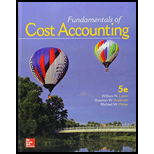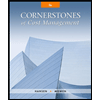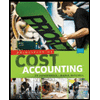
Concept explainers
a.
Prepare a production cost report using FIFO.
a.
Explanation of Solution
First in and first out (FIFO) method:
Under this method cost of units sold and units lying as ending inventory is ascertained on the first in and first out basis. It means units entered in the store first would be sold out first.
Compute the total units of prior department, materials, labor and manufacturing
| Particulars | Physical units | Prior department | Materials | Labor | Manufacturing overhead |
| Beginning work-in-process inventory | 75,000 | ||||
| Units started this period | 375,000 | ||||
| Total units | 450,000 | ||||
| Completed and transferred out | |||||
| Beginning work-in-process inventory | 75,000 | - | - | 30,000(1) | 37,500(2) |
| Started and currently completed | 225,000 | 225,000 | 225,000 | 225,000 | 225,000 |
| Units in ending work-in-process inventory | 150,000 | 150,000 | 135,000(3) | 105,000(4) | 52,500(5) |
| Total units | 450,000 | 375,000 | 360,000 | 360,000 | 315,000 |
Table: (1)
Compute the cost per equivalent unit of prior department, materials, labor and manufacturing overhead:
| Particulars | Total | Prior department | Materials | Labor | Manufacturing overhead |
| Costs in beginning work-in-process inventory | $ 382,800 | $ 192,000 | $ 120,000 | $ 43,200 | $ 27,600 |
| Current period costs | $ 1,865,400 | $ 960,000 | $ 576,000 | $ 216,000 | $ 113,400 |
| Total costs | $ 2,248,200 | $ 1,152,000 | $ 696,000 | $ 259,200 | $ 141,000 |
| Cost per equivalent unit | |||||
| Prior department | $ 2.56(6) | ||||
| Materials | $ 1.60(7) | ||||
| Labor | $ 0.60(8) | ||||
| Manufacturing overhead | $ 0.36(9) |
Table: (2)
Compute the total cost of prior department, materials, labor and manufacturing overhead:
| Particulars | Total | Prior department | Materials | Labor | Manufacturing overhead |
| Transferred out: | |||||
| Costs from beginning inventory | $ 382,800 | $ 192,000 | $ 120,000 | $ 43,200 | $ 27,600 |
| Current costs beginning work-in-process inventory | |||||
| Prior department | $ 0 | $ 0 | |||
| Materials | $ 0 | $ 0 | |||
| Labor | $ 18,000 | $ 18,000(10) | |||
| Manufacturing overhead | $ 13,500 | $ 13,500(11) | |||
| Total costs | $ 414,300 | ||||
| Current costs of units started and completed | |||||
| Prior department | $ 576,000 | $ 576,000(12) | |||
| Materials | $ 360,000 | $ 360,000(13) | |||
| Labor | $ 135,000 | $ 135,000(14) | |||
| Manufacturing overhead | $ 81,000 | $ 81,000(15) | |||
| Total costs of units started and completed | $ 1,152,000 | ||||
| Total costs | $ 1,566,300 | $ 576,000 | $ 360,000 | $ 153,000 | $ 94,500 |
| Current costs work-in-process ending inventory | |||||
| Prior department | $ 384,000 | $ 384,000(16) | |||
| Materials | $ 216,000 | $ 216,000(17) | |||
| Labor | $ 63,000 | $ 63,000(18) | |||
| Manufacturing overhead | $ 18,900 | $ 18,900(19) | |||
| Total ending work-in-process inventory | $ 681,900 | ||||
| Total costs accounted for | $ 2,279,700 | $ 1,152,000 | $ 696,000 | $ 277,200 | $ 154,500 |
Table: (3)
Working note 1:
Compute the beginning inventory:
Working note 2:
Compute the beginning inventory:
Working note 3:
Compute the units in ending inventory:
Working note 4:
Compute the units in ending inventory:
Working note 5:
Compute the units in ending inventory:
Working note 6:
Compute the cost per equivalent unit:
Working note 7:
Compute the cost per equivalent unit:
Working note 8:
Compute the cost per equivalent unit:
Working note 9:
Compute the cost per equivalent unit:
Working note 10:
Compute the current costs added to complete beginning work-in-process inventory:
Working note 11:
Compute the current costs added to complete beginning work-in-process inventory:
Working note 12:
Compute the current costs of units started and completed:
Working note 13:
Compute the current costs of units started and completed:
Working note 14:
Compute the current costs of units started and completed:
Working note 15:
Compute the current costs of units started and completed:
Working note 16:
Compute the current costs of units started and completed:
Working note 17:
Compute the current costs of units started and completed:
Working note 18:
Compute the current costs of units started and completed:
Working note 19:
Compute the current costs of units started and completed:
b.
Determine whether the targets assigned by the management have been achieved or not. Write a short report on the same.
b.
Explanation of Solution
Computed cost per equivalent units:
| Particulars | Cost per equivalent unit |
| Materials | $ 1.60 |
| Labor | $ 0.60 |
| Manufacturing overhead | $ 0.36 |
Table: (4)
Targeted cost per equivalent units:
| Particulars | Cost per equivalent unit |
| Materials | $ 1.60 |
| Labor | $ 0.80 |
| Manufacturing overhead | $ 0.36 |
Table: (5)
Relevance of reported computed result and targeted result for materials, labor and manufacturing overhead:
The target determined by the management for materials and manufacturing overhead have been achieved. Only for labor the cost per equivalent unit has not achieved. The targeted cost per equivalent unit for labor was $0.80 but the actual cost per equivalent unit has been computed to $0.60. Thus, the target has been achieved and reduced further when computed using FIFO method for the computation.
Want to see more full solutions like this?
Chapter 8 Solutions
Fundamentals of Cost Accounting
- Bridgeport Electronics completes job #389, which has a standard of 450 labor hours at a standard rate of $24.75 per hour. The job was completed in 480 hours, and the average actual labor rate was $23.90 per hour. What is the labor efficiency (quantity) variance? (A negative number indicates a favorable variance and a positive number indicates an unfavorable variance.) Answerarrow_forwardI am looking for the correct answer to this general accounting problem using valid accounting standards.arrow_forwardIn 2020, it cost Jason Manufacturing $14 per unit to produce component R8. In 2021, it has increased to $18 per unit. In 2021, Eastern Supplies has offered to provide component R8 for $11 per unit to Jason. As it pertains to the make-or-buy decision, which statement is true? a. Net relevant costs are $3 per unit b. Incremental revenues are $4 per unit c. Differential costs are $7 per unit d. Incremental costs are $4 per unitarrow_forward
- Please provide the answer to this general accounting question using the right approach.arrow_forwardThe Frida Corporation reported total manufacturing costs of $245,000; manufacturing overhead totaling $68,000 and direct materials totaling $57,000. How much is direct labor cost?arrow_forwardI need solution with step by step.....??????????????????????????arrow_forward
- At the beginning of the year, a company predicts total direct materials costs of $920,000 and total overhead costs of $1,150,000. If the company uses direct materials costs as its activity base to allocate overhead, what is the predetermined overhead rate it should use during the year?arrow_forwardCompute the required purchases for julyarrow_forwardCan you help me solve this general accounting question using the correct accounting procedures?arrow_forward
 Cornerstones of Cost Management (Cornerstones Ser...AccountingISBN:9781305970663Author:Don R. Hansen, Maryanne M. MowenPublisher:Cengage Learning
Cornerstones of Cost Management (Cornerstones Ser...AccountingISBN:9781305970663Author:Don R. Hansen, Maryanne M. MowenPublisher:Cengage Learning Managerial Accounting: The Cornerstone of Busines...AccountingISBN:9781337115773Author:Maryanne M. Mowen, Don R. Hansen, Dan L. HeitgerPublisher:Cengage LearningPrinciples of Accounting Volume 2AccountingISBN:9781947172609Author:OpenStaxPublisher:OpenStax College
Managerial Accounting: The Cornerstone of Busines...AccountingISBN:9781337115773Author:Maryanne M. Mowen, Don R. Hansen, Dan L. HeitgerPublisher:Cengage LearningPrinciples of Accounting Volume 2AccountingISBN:9781947172609Author:OpenStaxPublisher:OpenStax College Principles of Cost AccountingAccountingISBN:9781305087408Author:Edward J. Vanderbeck, Maria R. MitchellPublisher:Cengage Learning
Principles of Cost AccountingAccountingISBN:9781305087408Author:Edward J. Vanderbeck, Maria R. MitchellPublisher:Cengage Learning Managerial AccountingAccountingISBN:9781337912020Author:Carl Warren, Ph.d. Cma William B. TaylerPublisher:South-Western College Pub
Managerial AccountingAccountingISBN:9781337912020Author:Carl Warren, Ph.d. Cma William B. TaylerPublisher:South-Western College Pub Financial And Managerial AccountingAccountingISBN:9781337902663Author:WARREN, Carl S.Publisher:Cengage Learning,
Financial And Managerial AccountingAccountingISBN:9781337902663Author:WARREN, Carl S.Publisher:Cengage Learning,





